Interior JAGUAR XJ 2004 X350 / 3.G User Guide
[x] Cancel search | Manufacturer: JAGUAR, Model Year: 2004, Model line: XJ, Model: JAGUAR XJ 2004 X350 / 3.GPages: 227, PDF Size: 4.22 MB
Page 54 of 227
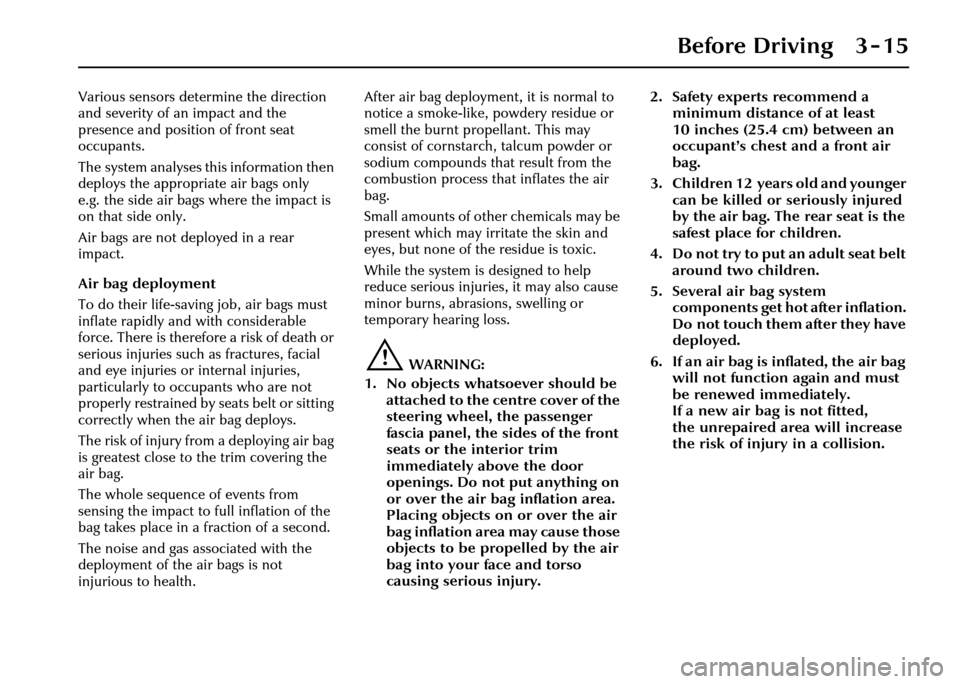
Before Driving 3 - 15
Various sensors determine the direction
and severity of an impact and the
presence and position of front seat
occupants.
The system analyses this information then
deploys the appropriate air bags only
e.g. the side air bags where the impact is
on that side only.
Air bags are not deployed in a rear
impact.
Air bag deployment
To do their life-saving job, air bags must
inflate rapidly and with considerable
force. There is therefore a risk of death or
serious injuries such as fractures, facial
and eye injuries or internal injuries,
particularly to occupants who are not
properly restrained by seats belt or sitting
correctly when the air bag deploys.
The risk of injury fr om a deploying air bag
is greatest close to the trim covering the
air bag.
The whole sequence of events from
sensing the impact to full inflation of the
bag takes place in a fraction of a second.
The noise and gas associated with the
deployment of the air bags is not
injurious to health. After air bag deployme
nt, it is normal to
notice a smoke-like, powdery residue or
smell the burnt propellant. This may
consist of cornstarch, talcum powder or
sodium compounds that result from the
combustion process that inflates the air
bag.
Small amounts of other chemicals may be
present which may irri tate the skin and
eyes, but none of the residue is toxic.
While the system is designed to help
reduce serious injuries, it may also cause
minor burns, abrasions, swelling or
temporary hearing loss.
!WARNING:
1. No objects whatso ever should be
attached to the centre cover of the
steering wheel, the passenger
fascia panel, the sides of the front
seats or the interior trim
immediately above the door
openings. Do not put anything on
or over the air bag inflation area.
Placing objects on or over the air
bag inflation area may cause those
objects to be propelled by the air
bag into your face and torso
causing serious injury. 2. Safety experts recommend a
minimum distance of at least
10 inches (25.4 cm) between an
occupant’s chest and a front air
bag.
3. Children 12 years old and younger can be killed or seriously injured
by the air bag. The rear seat is the
safest place for children.
4. Do not try to put an adult seat belt around two children.
5. Several air bag system components get hot after inflation.
Do not touch them after they have
deployed.
6. If an air bag is inflated, the air bag will not function again and must
be renewed immediately.
If a new air bag is not fitted,
the unrepaired area will increase
the risk of injury in a collision.
Page 63 of 227
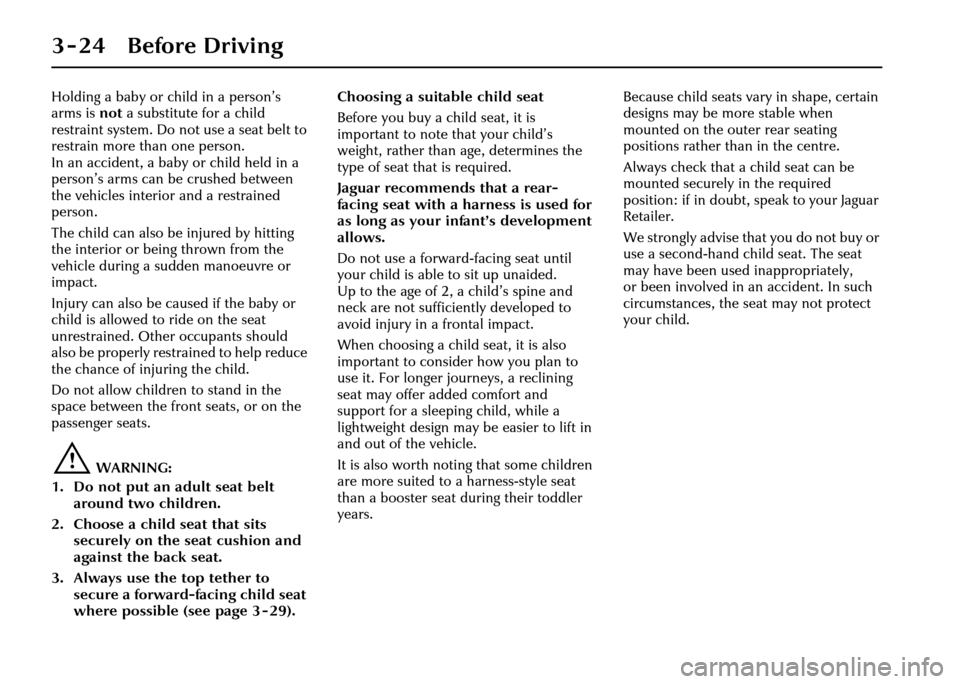
3 - 24 Before Driving
Holding a baby or child in a person’s
arms is not a substitute for a child
restraint system. Do not use a seat belt to
restrain more than one person.
In an accident, a baby or child held in a
person’s arms can be crushed between
the vehicles interior and a restrained
person.
The child can also be injured by hitting
the interior or being thrown from the
vehicle during a sudden manoeuvre or
impact.
Injury can also be caused if the baby or
child is allowed to ride on the seat
unrestrained. Other occupants should
also be properly restra ined to help reduce
the chance of injuring the child.
Do not allow children to stand in the
space between the front seats, or on the
passenger seats.
!WARNING:
1. Do not put an adult seat belt around two children.
2. Choose a child seat that sits
securely on the seat cushion and
against the back seat.
3. Always use the top tether to secure a forward-facing child seat
where possible (see page 3 - 29). Choosing a suitable child seat
Before you buy a child seat, it is
important to note that your child’s
weight, rather than age, determines the
type of seat that is required.
Jaguar recommends that a rear-
facing seat with a harness is used for
as long as your infant’s development
allows.
Do not use a forward-facing seat until
your child is able to sit up unaided.
Up to the age of 2, a child’s spine and
neck are not sufficiently developed to
avoid injury in a frontal impact.
When choosing a child seat, it is also
important to consider how you plan to
use it. For longer journeys, a reclining
seat may offer a
dded comfort and
support for a sleepin g child, while a
lightweight design may be easier to lift in
and out of the vehicle.
It is also worth noting that some children
are more suited to a harness-style seat
than a booster seat during their toddler
years. Because child seats vary in shape, certain
designs may be more stable when
mounted on the ou
ter rear seating
positions rather than in the centre.
Always check that a child seat can be
mounted securely in the required
position: if in doubt, speak to your Jaguar
Retailer.
We strongly advise that you do not buy or
use a second-hand child seat. The seat
may have been used inappropriately,
or been involved in an accident. In such
circumstances, the seat may not protect
your child.
Page 89 of 227
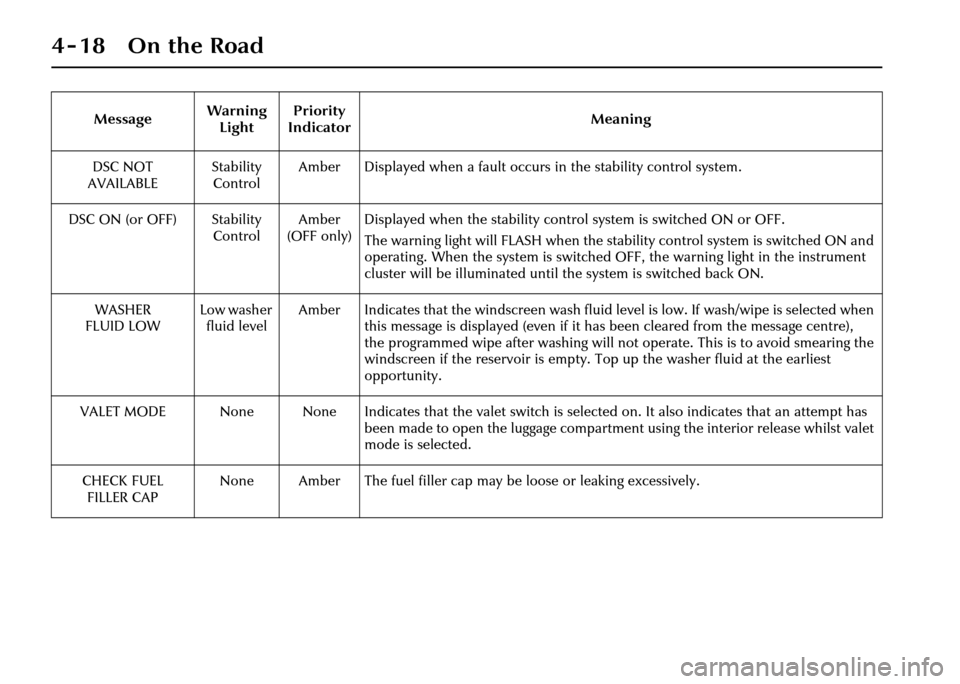
4-18 On the Road
DSC NOT
AVAILABLE Stability
Control Amber Displayed when a fault occurs in the stability control system.
DSC ON (or OFF) Stability ControlAmber
(OFF only) Displayed when the stability contro
l system is switched ON or OFF.
The warning light will FLASH when the stability control system is switched ON and
operating. When the system is switched OFF, the warning light in the instrument
cluster will be illuminated until the system is switched back ON.
WASHER
FLUID LOW Low washer
fluid level Amber Indicates that the windscreen wash fluid level is low. If wash/wipe is selected when
this message is displayed (even if it has been cleared from the message centre),
the programmed wipe after wash ing will not operate. This is to avoid smearing the
windscreen if the reservoir is empty. To p up the washer fluid at the earliest
opportunity.
VALET MODE None None Indicates that the valet switch is selected on. It also indicates that an attempt has been made to open the luggage compartment using the interior release whilst valet
mode is selected.
CHECK FUEL FILLER CAP None Amber The fuel filler cap may be loose or leaking excessively.
Message
Warning
Light Priority
Indicator Meaning
Page 98 of 227
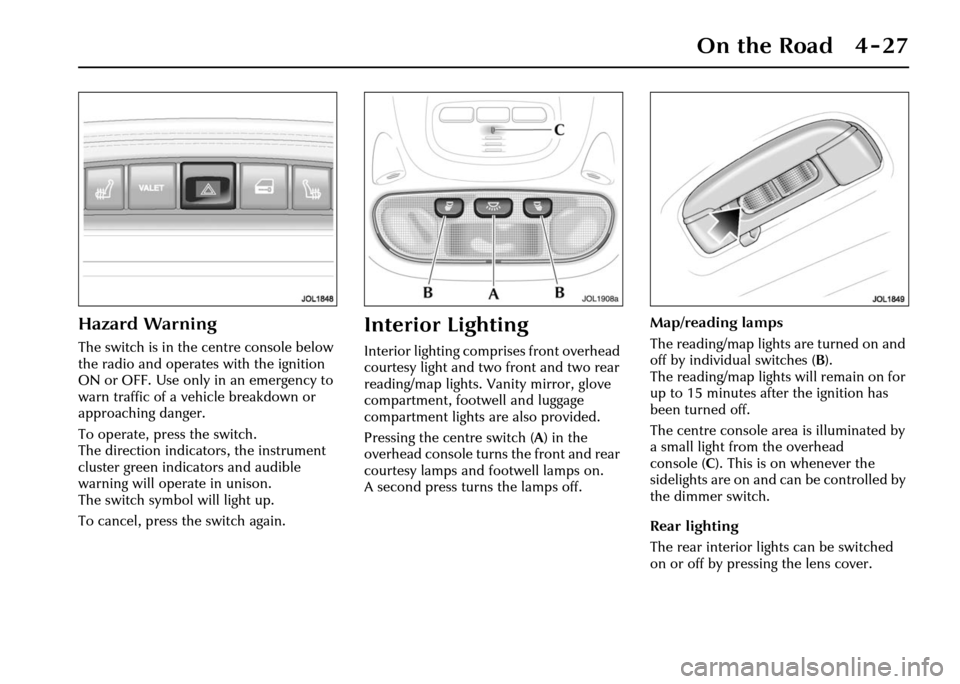
On the Road 4 - 27
Hazard Warning
The switch is in the centre console below
the radio and operates with the ignition
ON or OFF. Use only in an emergency to
warn traffic of a vehicle breakdown or
approaching danger.
To operate, press the switch.
The direction indicators, the instrument
cluster green indicators and audible
warning will operate in unison.
The switch symbol will light up.
To cancel, press the switch again.
Interior Lighting
Interior lighting comp rises front overhead
courtesy light and tw o front and two rear
reading/map lights. Vanity mirror, glove
compartment, footwell and luggage
compartment lights are also provided.
Pressing the centre switch ( A) in the
overhead console turns the front and rear
courtesy lamps and footwell lamps on.
A second press turns the lamps off. Map/reading lamps
The reading/map lights are turned on and
off by individual switches (
B).
The reading/map lights will remain on for
up to 15 minutes after the ignition has
been turned off.
The centre console area is illuminated by
a small light from the overhead
console ( C). This is on whenever the
sidelights are on and can be controlled by
the dimmer switch.
Rear lighting
The rear interior ligh ts can be switched
on or off by pressing the lens cover.
Page 99 of 227
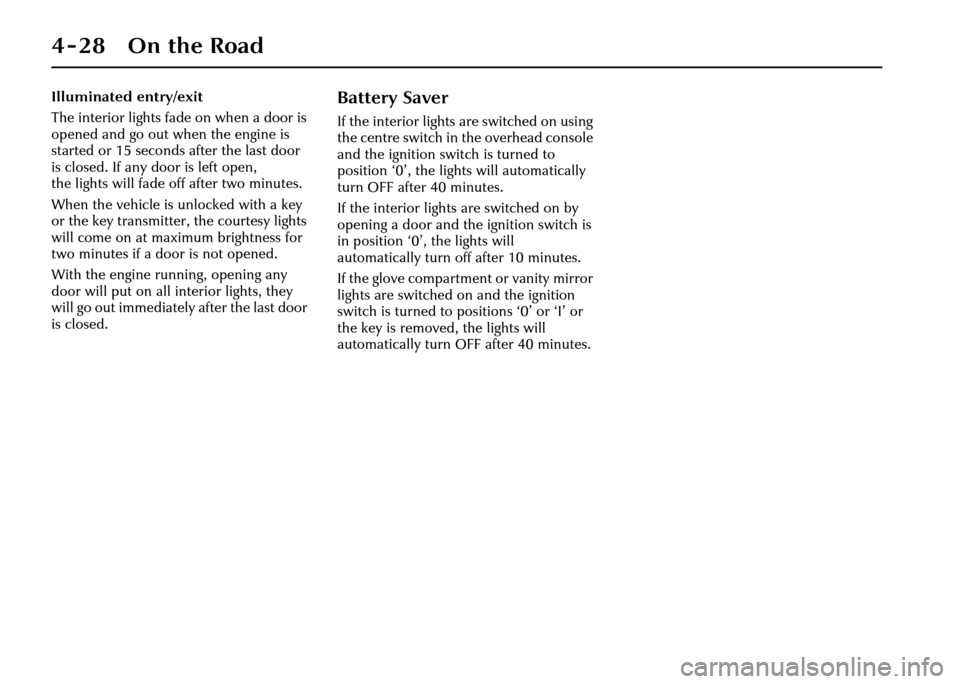
4-28 On the Road
Illuminated entry/exit
The interior lights fade on when a door is
opened and go out when the engine is
started or 15 seconds after the last door
is closed. If any door is left open,
the lights will fade off after two minutes.
When the vehicle is unlocked with a key
or the key transmitter, the courtesy lights
will come on at maximum brightness for
two minutes if a door is not opened.
With the engine running, opening any
door will put on all interior lights, they
will go out immediately after the last door
is closed.Battery Saver
If the interior lights are switched on using
the centre switch in the overhead console
and the ignition swit ch is turned to
position ‘0’, the lights will automatically
turn OFF after 40 minutes.
If the interior lights are switched on by
opening a door and the ignition switch is
in position ‘0’, the lights will
automatically turn off after 10 minutes.
If the glove compartmen t or vanity mirror
lights are switched on and the ignition
switch is turned to positions ‘0’ or ‘I’ or
the key is removed, the lights will
automatically turn OFF after 40 minutes.
Page 108 of 227
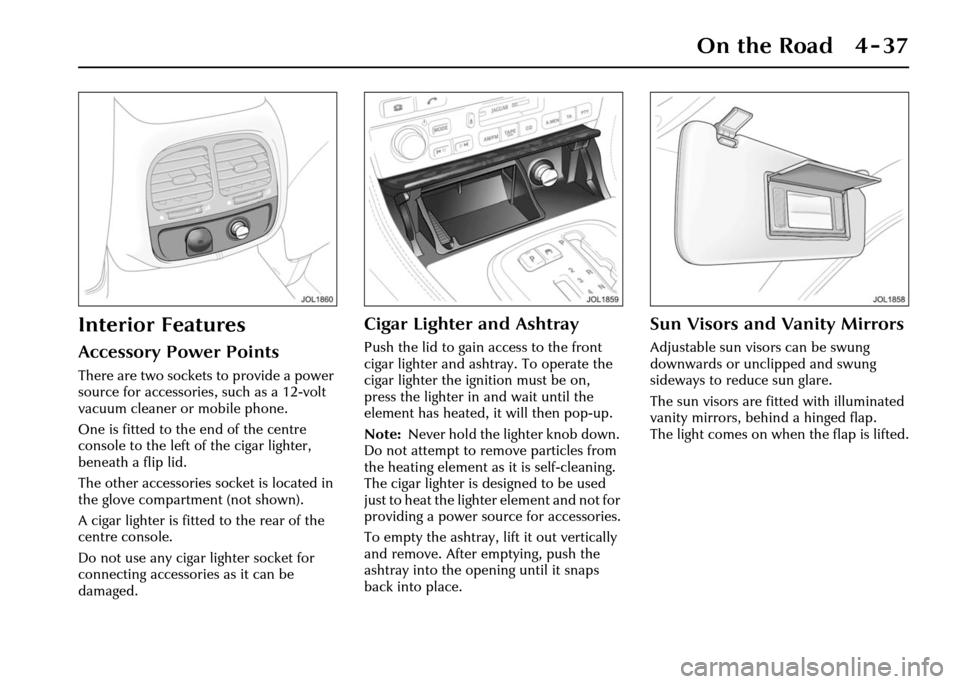
On the Road 4 - 37
Interior Features
Accessory Power Points
There are two sockets to provide a power
source for accessories, such as a 12-volt
vacuum cleaner or mobile phone.
One is fitted to the end of the centre
console to the left of the cigar lighter,
beneath a flip lid.
The other accessories socket is located in
the glove compartment (not shown).
A cigar lighter is fitted to the rear of the
centre console.
Do not use any cigar lighter socket for
connecting accessories as it can be
damaged.
Cigar Lighter and Ashtray
Push the lid to gain access to the front
cigar lighter and ashtray. To operate the
cigar lighter the ignition must be on,
press the lighter in and wait until the
element has heated, it will then pop-up.
Note:Never hold the lighter knob down.
Do not attempt to remove particles from
the heating element as it is self-cleaning.
The cigar lighter is designed to be used
just to heat the lighter element and not for
providing a power source for accessories.
To empty the ashtray, lift it out vertically
and remove. After emptying, push the
ashtray into the opening until it snaps
back into place.
Sun Visors and Vanity Mirrors
Adjustable sun visors can be swung
downwards or unclipped and swung
sideways to reduce sun glare.
The sun visors are fitted with illuminated
vanity mirrors, behind a hinged flap.
The light comes on when the flap is lifted.
Page 142 of 227
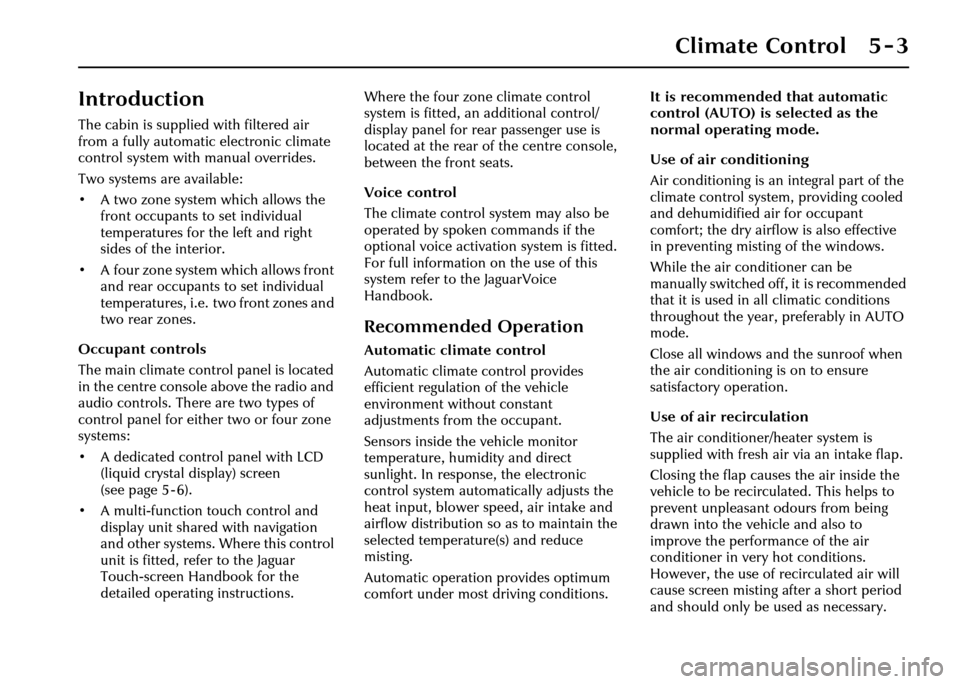
Climate Control 5 - 3
5 Climate Control
Introduction
The cabin is supplied with filtered air
from a fully automatic electronic climate
control system with manual overrides.
Two systems are available:
• A two zone system which allows the front occupants to set individual
temperatures for the left and right
sides of the interior.
• A four zone system which allows front and rear occupants to set individual
temperatures, i.e. two front zones and
two rear zones.
Occupant controls
The main climate control panel is located
in the centre console above the radio and
audio controls. There are two types of
control panel for either two or four zone
systems:
• A dedicated control panel with LCD (liquid crystal display) screen
(see page 5 - 6).
• A multi-function touch control and display unit shared with navigation
and other systems. Where this control
unit is fitted, refer to the Jaguar
Touch-screen Handbook for the
detailed operating instructions. Where the four zone climate control
system is fitted, an additional control/
display panel for rear passenger use is
located at the rear of the centre console,
between the front seats.
Voice control
The climate control system may also be
operated by spoken commands if the
optional voice activation system is fitted.
For full information on the use of this
system refer to the JaguarVoice
Handbook.
Recommended Operation
Automatic climate control
Automatic climate control provides
efficient regulation of the vehicle
environment without constant
adjustments from the occupant.
Sensors inside the vehicle monitor
temperature, humidity and direct
sunlight. In response, the electronic
control system automatically adjusts the
heat input, blower speed, air intake and
airflow distribution so as to maintain the
selected temperature(s) and reduce
misting.
Automatic operation provides optimum
comfort under most driving conditions. It is recommended that automatic
control (AUTO) is selected as the
normal operating mode.
Use of air conditioning
Air conditioning is an integral part of the
climate control system, providing cooled
and dehumidified
air for occupant
comfort; the dry airflow is also effective
in preventing misting of the windows.
While the air conditioner can be
manually switched off, it is recommended
that it is used in all climatic conditions
throughout the year, preferably in AUTO
mode.
Close all windows and the sunroof when
the air conditioning is on to ensure
satisfactory operation.
Use of air recirculation
The air conditioner/heater system is
supplied with fresh air via an intake flap.
Closing the flap causes the air inside the
vehicle to be recirculated. This helps to
prevent unpleasant odours from being
drawn into the vehicle and also to
improve the performance of the air
conditioner in very hot conditions.
However, the use of recirculated air will
cause screen misting after a short period
and should only be used as necessary.
Page 148 of 227
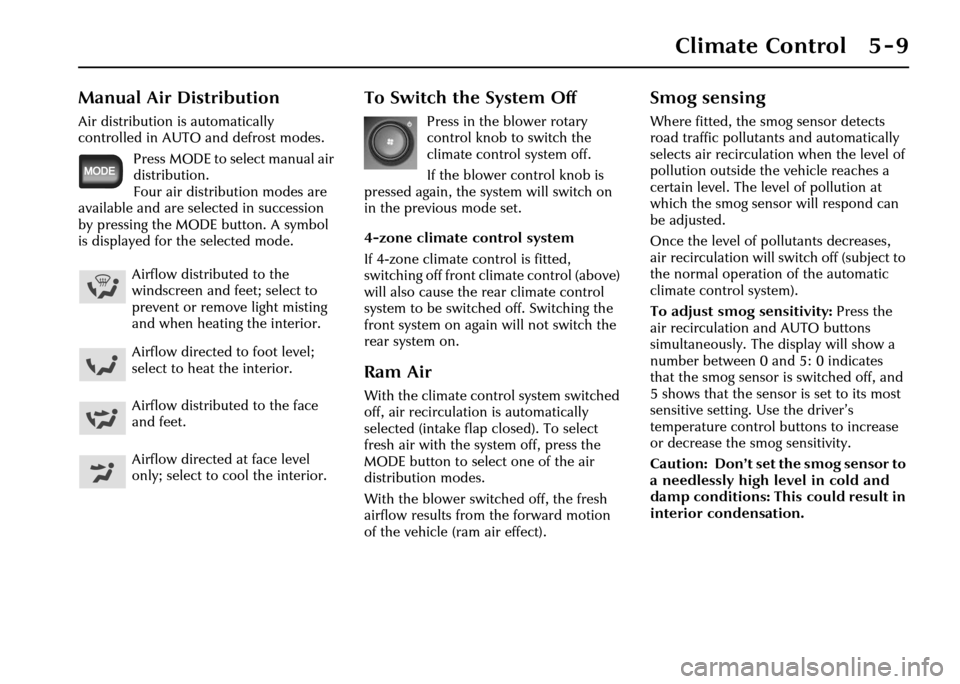
Climate Control 5 - 9
Manual Air Distribution
Air distribution is automatically
controlled in AUTO and defrost modes.Press MODE to select manual air
distribution.
Four air distribution modes are
available and are selected in succession
by pressing the MODE button. A symbol
is displayed for the selected mode.
To Switch the System Off
Press in the blower rotary
control knob to switch the
climate control system off.
If the blower control knob is
pressed again, the system will switch on
in the previous mode set.
4-zone climate control system
If 4-zone climate control is fitted,
switching off front climate control (above)
will also cause the rear climate control
system to be switched off. Switching the
front system on again will not switch the
rear system on.
Ram Air
With the climate control system switched
off, air recirculation is automatically
selected (intake flap closed). To select
fresh air with the system off, press the
MODE button to select one of the air
distribution modes.
With the blower switched off, the fresh
airflow results from the forward motion
of the vehicle (ram air effect).
Smog sensing
Where fitted, the smog sensor detects
road traffic pollutants and automatically
selects air recirculation when the level of
pollution outside the vehicle reaches a
certain level. The level of pollution at
which the smog sensor will respond can
be adjusted.
Once the level of pollutants decreases,
air recirculation will switch off (subject to
the normal operation of the automatic
climate control system).
To adjust smog sensitivity: Press the
air recirculation and AUTO buttons
simultaneously. The display will show a
number between 0 and 5: 0 indicates
that the smog sensor is switched off, and
5 shows that the sensor is set to its most
sensitive setting. Use the driver’s
temperature control bu ttons to increase
or decrease the smog sensitivity.
Caution: Don’t set the smog sensor to
a needlessly high level in cold and
damp conditions: This could result in
interior condensation.
Airflow distributed to the
windscreen and feet; select to
prevent or remove light misting
and when heating the interior.
Airflow directed to foot level;
select to heat the interior.
Airflow distributed to the face
and feet.
Airflow directed at face level
only; select to cool the interior.
Page 184 of 227
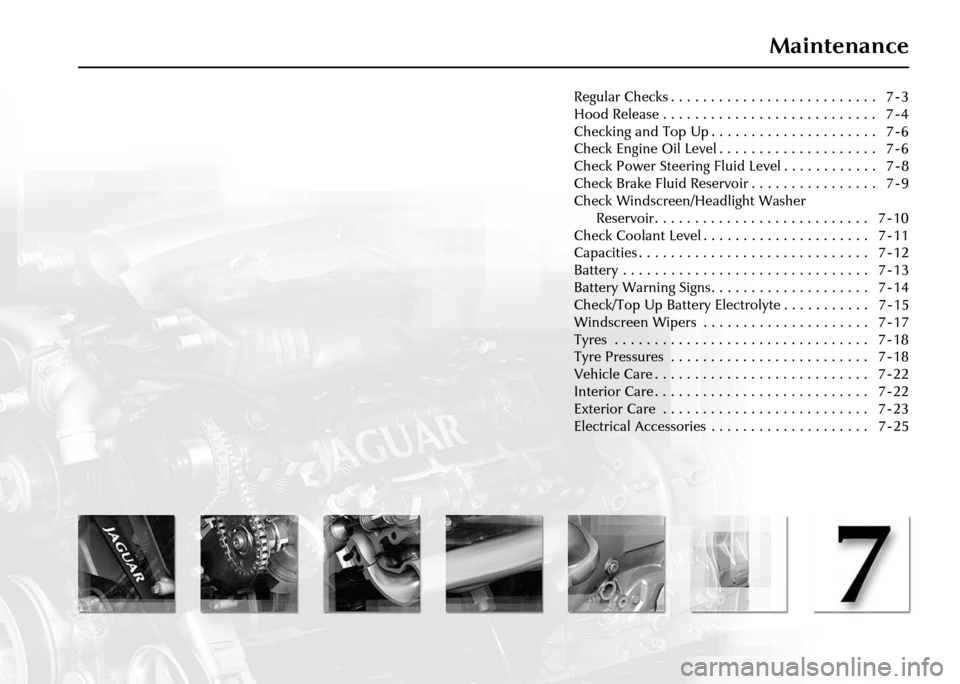
Maintenance
Regular Checks . . . . . . . . . . . . . . . . . . . . . . . . . . 7 - 3
Hood Release . . . . . . . . . . . . . . . . . . . . . . . . . . . 7 - 4
Checking and Top Up . . . . . . . . . . . . . . . . . . . . . 7 - 6
Check Engine Oil Level . . . . . . . . . . . . . . . . . . . . 7 - 6
Check Power Steering Fluid Level . . . . . . . . . . . . 7 - 8
Check Brake Fluid Reservoir . . . . . . . . . . . . . . . . 7 - 9
Check Windscreen/Headlight Washer Reservoir. . . . . . . . . . . . . . . . . . . . . . . . . . . 7 - 10
Check Coolant Level . . . . . . . . . . . . . . . . . . . . . 7 - 11
Capacities . . . . . . . . . . . . . . . . . . . . . . . . . . . . . 7 - 12
Battery . . . . . . . . . . . . . . . . . . . . . . . . . . . . . . . 7 - 13
Battery Warning Signs. . . . . . . . . . . . . . . . . . . . 7 - 14
Check/Top Up Battery Electrolyte . . . . . . . . . . . 7 - 15
Windscreen Wipers . . . . . . . . . . . . . . . . . . . . . 7 - 17
Tyres . . . . . . . . . . . . . . . . . . . . . . . . . . . . . . . . 7 - 18
Tyre Pressures . . . . . . . . . . . . . . . . . . . . . . . . . 7 - 18
Vehicle Care . . . . . . . . . . . . . . . . . . . . . . . . . . . 7 - 22
Interior Care . . . . . . . . . . . . . . . . . . . . . . . . . . . 7 - 22
Exterior Care . . . . . . . . . . . . . . . . . . . . . . . . . . 7 - 23
Electrical Accessories . . . . . . . . . . . . . . . . . . . . 7 - 25
Page 205 of 227
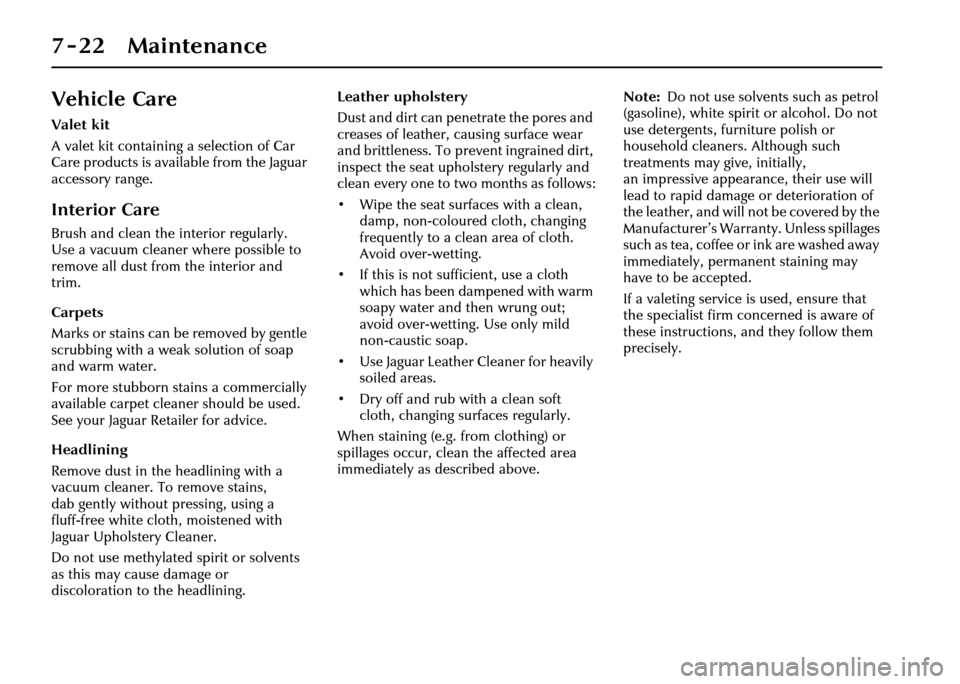
7-22 Maintenance
Vehicle Care
Valet kit
A valet kit containing a selection of Car
Care products is available from the Jaguar
accessory range.
Interior Care
Brush and clean the interior regularly.
Use a vacuum cleaner where possible to
remove all dust from the interior and
trim.
Carpets
Marks or stains can be removed by gentle
scrubbing with a weak solution of soap
and warm water.
For more stubborn stains a commercially
available carpet cleaner should be used.
See your Jaguar Retailer for advice.
Headlining
Remove dust in the headlining with a
vacuum cleaner. To remove stains,
dab gently without pressing, using a
fluff-free white cloth, moistened with
Jaguar Upholstery Cleaner.
Do not use methylated spirit or solvents
as this may cause damage or
discoloration to the headlining.Leather upholstery
Dust and dirt can penetrate the pores and
creases of leather, causing surface wear
and brittleness. To prevent ingrained dirt,
inspect the seat upholstery regularly and
clean every one to two months as follows:
• Wipe the seat surfaces with a clean,
damp, non-coloured cloth, changing
frequently to a clean area of cloth.
Avoid over-wetting.
• If this is not sufficient, use a cloth which has been dampened with warm
soapy water and then wrung out;
avoid over-wetting. Use only mild
non-caustic soap.
• Use Jaguar Leather Cleaner for heavily soiled areas.
• Dry off and rub with a clean soft cloth, changing su rfaces regularly.
When staining (e.g. from clothing) or
spillages occur, clean the affected area
immediately as described above. Note:
Do not use solvents such as petrol
(gasoline), white spirit or alcohol. Do not
use detergents, furniture polish or
household cleaners. Although such
treatments may give, initially,
an impressive appearance, their use will
lead to rapid damage or deterioration of
the leather, and will not be covered by the
Manufacturer’s Warranty. Unless spillages
such as tea, coffee or ink are washed away
immediately, permanent staining may
have to be accepted.
If a valeting service is used, ensure that
the specialist firm concerned is aware of
these instructions, and they follow them
precisely.